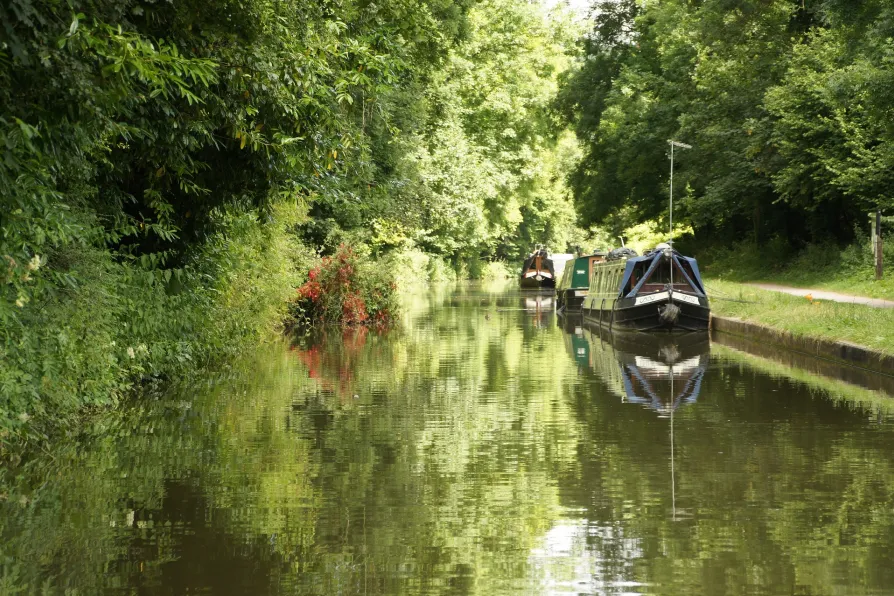VINCE MILLS cautions over the perils and pitfalls of ‘a new left party’

 All kinds of surprising species can be found by the canal
All kinds of surprising species can be found by the canal
BRITAIN has over 3,000 miles of inland waterways, and towpaths walks are a wonderful way to get to get out and enjoy the natural environment.
Not all the plants and animals you will see on your walks are welcome here.
Invasive species can do much damage to our native plants and animals and, amazingly, some can actually damage the very structure of the canals and rivers we enjoy.
Some arrived by ship, often stowing away or attached to the hull. They dropped off in our British ports and from there migrated along the canals.
Others were deliberately brought here because of their beauty or interest.
I have written before about the red-eared terrapin, which arrived as pets during the Teenage Mutant Hero Turtles cartoon craze of the 1980s.
They grew big and strong enough to break out of the small plastic tanks they were usually kept in. [[{"fid":"25325","view_mode":"inlinefull","fields":{"format":"inlinefull","field_file_image_alt_text[und][0][value]":"A red-eared terrapin"},"type":"media","field_deltas":{"1":{"format":"inlinefull","field_file_image_alt_text[und][0][value]":"A red-eared terrapin"}},"link_text":null,"attributes":{"alt":"A red-eared terrapin","height":"440","width":"660","class":"media-element file-inlinefull","data-delta":"1"}}]]
Many escaped or were dumped into our waterways and park lakes and have grown to the size of a dinner plate, eating native amphibians, insect larvae, fish and birds’ eggs.
It may be that some recent really hot spells have enabled terrapin eggs to hatch.
Back in 1839 a really beautiful plant arrived at Kew Gardens from the Himalayas.
A type of balsam, it had stout red stems and deep purple to pink flowers.
Today that Himalayan balsam forms dense thickets that shade out all other plants along miles and miles of canal towpath. It is pretty but it just doesn’t allow any other plants room or light to grow.[[{"fid":"25326","view_mode":"inlinefull","fields":{"format":"inlinefull","field_file_image_alt_text[und][0][value]":"Himalayan balsam is hard to keep at bay"},"type":"media","field_deltas":{"1":{"format":"inlinefull","field_file_image_alt_text[und][0][value]":"Himalayan balsam is hard to keep at bay"}},"link_text":null,"attributes":{"alt":"Himalayan balsam is hard to keep at bay","height":"440","width":"660","class":"media-element file-inlinefull","data-delta":"1"}}]]
Each season each balsam plant produces around 800 seeds, which it can shoot up to 25 feet.
Seeds often fall in the water and are transferred to banks even further away.
Balsam can only be controlled by removing individual plants by hand on a regular basis and cutting it back before it seeds.
Perhaps our most romantic invader is the mink. Looking something between a cat and a ferret, it is often mistaken for our native otter.
As both animals become far more numerous, misidentifications between otters and mink are surprisingly common.
How mink got here is more of a puzzle than you might think. Many suggest it arrived in the 1930s when many mink fur farms were established here. [[{"fid":"25327","view_mode":"inlinefull","fields":{"format":"inlinefull","field_file_image_alt_text[und][0][value]":"Mink should not be confused with otters"},"type":"media","field_deltas":{"1":{"format":"inlinefull","field_file_image_alt_text[und][0][value]":"Mink should not be confused with otters"}},"link_text":null,"attributes":{"alt":"Mink should not be confused with otters","height":"444","width":"660","class":"media-element file-inlinefull","data-delta":"1"}}]]
The wild mink of today, however, are much more like the dark brown wild native mink and most experts think our current stocks have been deliberately, if misguidedly, introduced.
Mink were first reported to be breeding wild in 1956 and since then numbers have risen rapidly.
We just don’t know how many there are today happily eating fish, small mammals, birds and invertebrates. We do know it is a huge number.
The largest casualty of the mink’s presence has been our native water vole, whose numbers have declined by 95 per cent because of loss of habitat due to mink invasion.
Canal walkers in both London and Wales have discovered colonies of Aesculapian snakes from central and southern Europe.
Growing up to six foot six inches in length, it is among the largest European snakes. They are beautifully camouflaged and very hard to spot.
Non-venomous and, like all snakes, afraid of people, they will hurry away if you go near.
They eat mainly rats, always common along the canal network. They are believed to be either zoo escapees or deliberate releases by enthusiasts keen to increase the British snake population.
I’ve written before about the red signal crayfish. In the 1970s, the British government introduced the signal crayfish (Pacifastacus leniusculus) from North America to British waters for export to the lucrative Scandinavian market.
Crayfish plague had ravaged native crayfish populations in Europe and it was seen as an attractive commercial species. [[{"fid":"25328","view_mode":"inlinefull","fields":{"format":"inlinefull","field_file_image_alt_text[und][0][value]":"The signal crayfish (Pic: Astacoides/Creative Commons)"},"type":"media","field_deltas":{"1":{"format":"inlinefull","field_file_image_alt_text[und][0][value]":"The signal crayfish (Pic: Astacoides/Creative Commons)"}},"link_text":null,"attributes":{"alt":"The signal crayfish (Pic: Astacoides/Creative Commons)","height":"438","width":"660","class":"media-element file-inlinefull","data-delta":"1"}}]]
Unfortunately it carried crayfish plague and passed the deadly disease to the native white-clawed crayfish (Austropotamobius pallipes) in Britain.
Signal crayfish soon escaped from commercial fisheries and began to outcompete the native white-clawed crayfish for habitat and food.
They have decimated the native crayfish populations where present.
Signal crayfish cause further problems by burrowing into river and canal banks, causing erosion, bank collapse and sediment pollution.
The signal crayfish is a voracious predator, feeding on a variety of fish, frogs and invertebrates, as well as plants, and even eating other signal crays, individuals of its own species. Some got away and spread really widely.
People were encouraged to catch and eat them and I can vouch for the fact they were delicious but now numbers have reduced dramatically and nobody seems to know why.
Another pest we may have to patriotically cook and eat to save our waterways is the Chinese mitten crab.
It takes its name from its large furry white-tipped claws. It first arrived as tiny larvae in the ballast tanks of ships around 1935.
It is a fast breeder with a voracious appetite, feeding on a wide range of native invertebrates and eggs of fish.
Its advance along our canals and rivers, though relatively slow, seems unstoppable.
These crabs are already common in the Thames and Medway, with isolated records from the Tyne (Newcastle), the Tamar (near Plymouth) and recently Dungeness, Kent.
Sightings have also been recorded from Southfields reservoir near Castleford, Yorkshire.
Mitten crab flesh is good to eat, but gourmets tell me that the crab’s gonads in season are to die for.
So why don’t we encourage this delicious immigrant? Simply because, like the signal crayfish, the crab is a rampant burrower, it can even cause fragile canal and river banks to collapse.
One of my favourite invasive species is the Glis glis or edible dormouse. At the turn of the 20th century, banker and zoologist Lionel W Rothchild kept Glis glis, along with many other exotic creatures in his private collection at Tring, Hertfordshire.
He alone is to blame for many invasive species in our countryside.
The cute animal, looking just like a miniature red squirrel, got loose and the nearby Grand Union towpath proved an easy escape route. [[{"fid":"25329","view_mode":"inlinefull","fields":{"format":"inlinefull","field_file_image_alt_text[und][0][value]":"The edible dormouse (Pic: Azay/Creative Commons"},"type":"media","field_deltas":{"1":{"format":"inlinefull","field_file_image_alt_text[und][0][value]":"The edible dormouse (Pic: Azay/Creative Commons"}},"link_text":null,"attributes":{"alt":"The edible dormouse (Pic: Azay/Creative Commons","height":"495","width":"660","class":"media-element file-inlinefull","data-delta":"1"}}]]
When I lived by the canal at Watford — 20 miles south of Tring — Glis glis were frequent pests in my, and my neighbour’s, lofts.
All those invasive species and I haven’t even mentioned those like New Zealand pygmy-weed, water fern, water hyacinth and floating pennywort any of which can form a blanket of vegetation a foot thick from bank to bank totally blocking the waterway.
On the bank giant hogweed and gunnera, often called giant rhubarb, can turn the Grand Union towpath into a passable — or impassable — replica of the Amazonian jungle.
We have killer shrimp, and zebra mussels originally from the Black and Caspian Seas and discarded tropical fish have even found a warm home in many industrial cooling water outlets on the canal.
Overall the amount and diversity of waterway squatters is incredible as a stroll along your local towpath will soon demonstrate.
On one of my local waterside walks I see farmed water buffalo grazing beside the canal. In the sky above soars a great cattle egret.
I do hope someone is keeping a careful eye on them. If they get away they could turn my next narrow boat holiday into a voyage down the Brahmaputra.



















